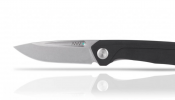Nathan the Machinist
KnifeMaker / Machinist / Evil Genius
Moderator
Knifemaker / Craftsman / Service Provider
- Joined
- Feb 13, 2007
- Messages
- 15,650
Nathan, I read the phrase "limited run" in one your most recent Kephart related posts, IIRC. I have been toying with the idea of adding another to my preorder because I always get at least one back up CPK (not named chopper) but my urge for instant gratification forces me toward scoring another one during the upcoming Fridays sales in 2021 as the CPK-Keps get produced and presented.
I am still leaning in this way to get at least one more but the word which you used, i.e, limited, leaves a bit too much to luck during the upcoming FS's. My original interpretation of "limited" was more along the lines of a non-recurring future pattern like one-and-done but if you could perhaps elaborate? If you mean something like 50 or so more on top of whatever the PO numbers end up, I may wish to reconsider my current decision by adding to my preorder to stave off the future needs to scramble. Thank you.
Yeah, I don't plan on this being a recurring pattern. The Kephart is something I had to get out of my system. I don't see re-visiting it again in the future. We'll make a few hundred of them and be done with it.

